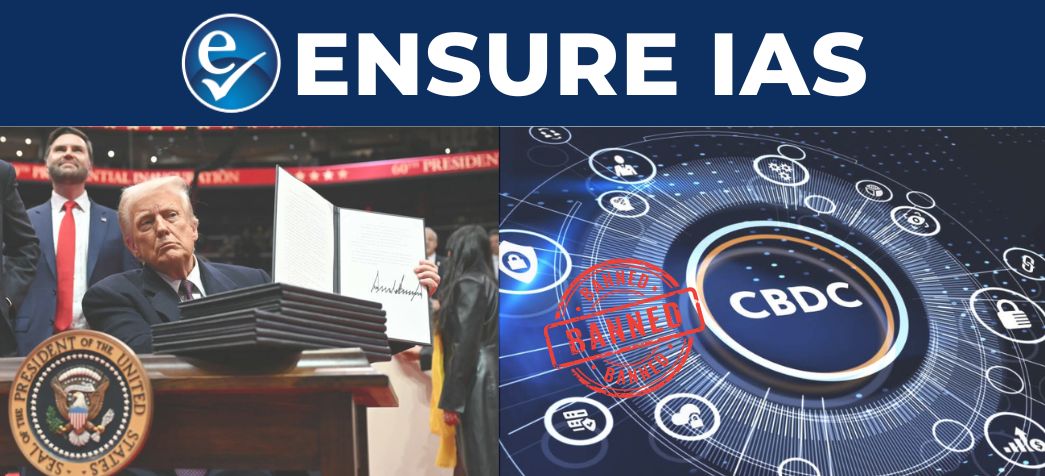- Courses
- GS Full Course 1 Year
- GS Full Course 2 Year
- GS Full Course 3 Year
- GS Full Course Till Selection
- Online Program
- GS Recorded Course
- NCERT (Recorded 500+ Hours)
- Polity Recorded Course
- Geography Recorded Course
- Economy Recorded Course
- AMAC Recorded Course
- Modern India, Post Independence & World History
- Environment Recoded Course
- Governance Recoded Course
- Science & Tech. Recoded Course
- International Relations and Internal Security Recorded Course
- Disaster Management Module Course
- Ethics Recoded Course
- Essay Recoded Course
- Current Affairs Recoded Course
- CSAT
- 5 LAYERED ARJUNA Mentorship
- Public Administration Optional
- ABOUT US
- OUR TOPPERS
- TEST SERIES
- FREE STUDY MATERIAL
- VIDEOS
- CONTACT US
Donald Trump Bans CBDC in the U.S.
Donald Trump Bans CBDC in the U.S.

- On January 25, 2025, U.S. President Donald Trump signed an executive order effectively banning the creation of a central bank digital currency (CBDC), commonly referred to as a digital dollar.
- This decision aligns with Trump’s broader goal of regulating the growing digital asset sector and maintaining U.S. dollar dominance in the global economy.
- The order has important implications not only for the future of digital finance but also for the role of cryptocurrencies in shaping financial systems worldwide.
Key Points from Trump’s Executive Order:
-
What is a CBDC?
- A CBDC is a form of digital currency that would be issued and controlled by the Federal Reserve, the central bank of the United States.
- It would be a digital version of the U.S. dollar and could be exchanged on digital platforms just like physical dollars.
- CBDCs would be designed to guarantee their value and enable easier transactions by offering a government-backed alternative to Cryptocurrencies like Bitcoin.
- The executive order effectively stops any plans for a digital dollar, meaning there will be no official U.S. CBDC in the near future.
-
Reasons Behind the Ban on CBDCs:
- A major concern raised by Trump’s administration is the potential loss of privacy.
- Since CBDCs would be fully traceable and issued by the government, there’s a risk that they could be used to track every financial transaction, violating individuals' privacy.
- Another reason for the ban is the desire to protect economic sovereignty.
- Centralized control of digital currency by the government could undermine the U.S.’s existing financial system and its ability to manage monetary policy.
- Trump’s administration believes that CBDCs could disrupt the traditional banking system, potentially leading to financial instability.
- The introduction of a CBDC could challenge the role of commercial banks and increase risks in the economy.
-
Shift Toward Private-Sector Digital Assets:
- Instead of CBDCs, Trump’s executive order encourages the development and use of private-sector digital assets, particularly stablecoins.
- Stablecoins are digital currencies pegged to a stable asset, typically the U.S. dollar, which makes them less volatile than traditional cryptocurrencies like Bitcoin.
- By supporting stablecoins, the U.S. government is promoting a private-driven digital economy, where the role of government-issued money is minimized, while still maintaining the U.S. dollar’s global dominance.
What is Stablecoin?
|
How is Stablecoin different from other cryptocurrency ?
|
Feature |
Stablecoin |
Other Cryptocurrencies |
|
Value Stability |
Pegged to a stable asset (e.g., USD), so it doesn’t fluctuate much. |
Can be highly volatile (e.g., Bitcoin, Ethereum). |
|
Price Movement |
Stable, usually around 1:1 with a fiat currency. |
Prices can rise and fall drastically. |
|
Purpose |
Used for transactions, savings, or as a store of value with low volatility. |
Can be used for investment or as a decentralized currency. |
|
Backing |
Often backed by reserves (USD or other assets). |
Not backed by anything; its value is based on demand. |
|
Examples |
USDT (Tether), USDC (USD Coin), DAI. |
Bitcoin (BTC), Ethereum (ETH), Litecoin (LTC). |
-
New Regulatory Framework for Digital Assets:
- The order also establishes a presidential working group given the responsibility of creating a regulatory framework for digital assets, including Bitcoin, stablecoins, and other cryptocurrencies. This group will focus on:
- Defining how digital assets should be integrated into the financial system.
- Ensuring that investors and consumers are safeguarded against scams or fraudulent activities.
- The order also establishes a presidential working group given the responsibility of creating a regulatory framework for digital assets, including Bitcoin, stablecoins, and other cryptocurrencies. This group will focus on:
-
National Digital Assets Stockpile:
- The executive order hints at the creation of a national digital assets stockpile, which could include cryptocurrencies like Bitcoin that have been seized by U.S. law enforcement.
- This aligns with Trump’s earlier promise to establish a strategic Bitcoin reserve, using seized digital assets to build a government-backed reserve of Bitcoin.
- The U.S. is estimated to hold 198,109 Bitcoins, valued at around $20.1 billion.
What Does This Mean for the Future of CBDCs?
- Trump’s stance is a direct challenge to countries that are actively developing CBDCs, such as China, Brazil, and South Korea, as well as those that have already launched their own digital currencies, like the Bahamas and Nigeria.
- These countries see CBDCs as a way to retain government control over their monetary systems and offer more secure and centralized digital assets.
- As the U.S. embraces private-sector solutions, it could create a competitive environment where countries with CBDCs may face growing pressure from the rise of decentralized digital assets like Bitcoin and stablecoins.
Global Crypto Ecosystem: Decentralization vs. Centralization:
- Trump’s executive order highlights the tension between decentralized cryptocurrencies (like Bitcoin) and centralized government-controlled digital currencies (like CBDCs).
- While decentralized systems are seen as promoting individual freedom and financial sovereignty, centralized CBDCs offer governments more control over monetary policy and economic management.
- This could lead to a broader debate about the future of money: whether governments will continue to push for more centralized control through CBDCs, or whether decentralized solutions like Bitcoin will eventually dominate.
|
Indian Central Bank Digital Currency (CBDC)
CBDC (Digital Rupee - e₹):
Key Features:
Storage:
Differences from Other Payment Methods:
Usage:
Wallet Limits:
Special Purpose Digital Rupee (PCBDC):
|
How is CBDC Different From Cryptocurrency?
|
Aspect |
CBDC (Digital Rupee) |
Cryptocurrency |
|
Issuance |
Issued by RBI, centralized |
Decentralized, issued by networks |
|
Regulation |
Government-controlled, legal tender |
Varies by country, often unregulated |
|
Value Stability |
Stable, 1 e₹ = 1 INR |
Volatile, prices fluctuate |
|
Legal Status |
Legal tender |
Varies, often unregulated or banned |
|
Transaction Mechanism |
Centralized, via RBI, based on Blockchain |
Decentralized, peer-to-peer blockchain |
|
Security |
Controlled by RBI, secure transactions |
Secured by blockchain, user-dependent |
|
Usage |
Domestic payments, integrated with banks |
Investment, peer-to-peer transactions |
|
Privacy |
Traceable by RBI |
Pseudo-anonymous, blockchain visible |




